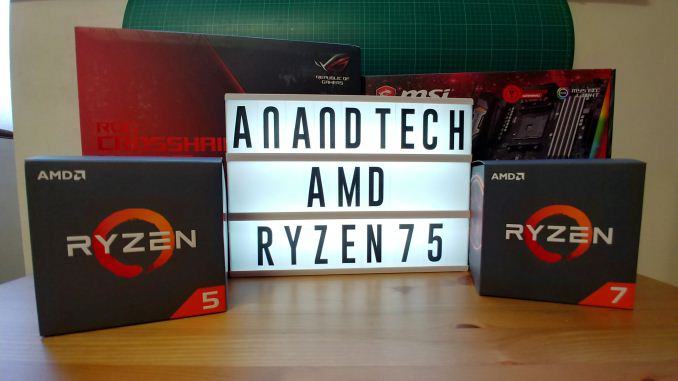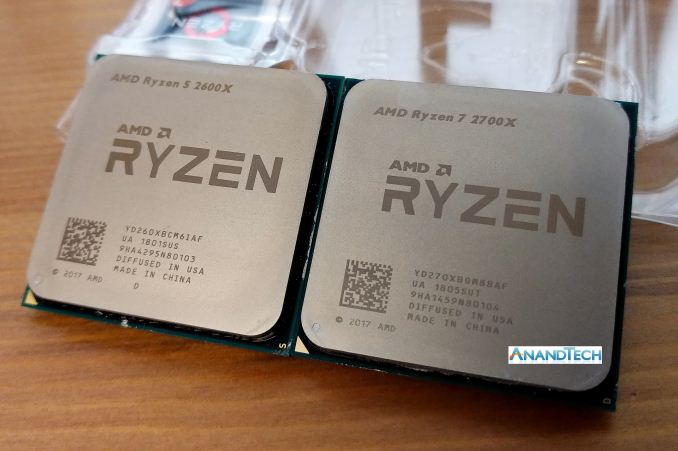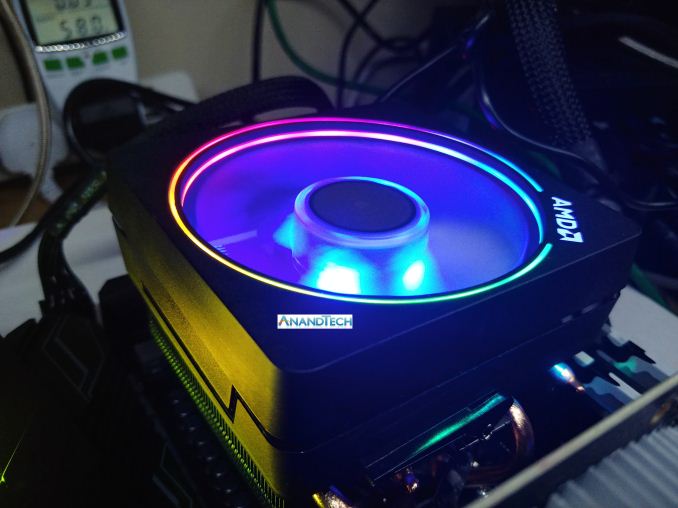The AMD 2nd Gen Ryzen Deep Dive: The 2700X, 2700, 2600X, and 2600 Tested
by Ian Cutress on April 19, 2018 9:00 AM EST
With 2017 finished, and Ryzen being very successful for AMD, the inevitable question was due: what happens next? Early in 2018, the plans were laid bare: a second generation Ryzen processor was set to come in mid-year, followed by a second generation Threadripper, using GlobalFoundries’ 12nm process. This is not AMD’s next big microarchitecture, which we know is called Zen 2 on 7nm, but an opportunity to launch a wave of components with minor improvements and take advantage of a manufacturing process that gives more frequency and more performance. Today AMD is launching four CPUs, and we have tested them all.
Updates
- (4/21) Some of our results, initially thought due to Spectre/Meltdown patches, were not in line with others. Testing audit was started.
- (4/25) Our extensive internal audit showed reasons for the differences, as documented in detail in this follow-up article. In short, an issue with a non-standard use timers on Windows was causing the performance of both AMD and Intel processors to dip, particularly impacting the latter.
- (5/2) Benchmark results have been updated.
- (5/22) X470 Motherboard. StoreMI, and Power Analysis pages updated.
- (5/26) Conclusion Updated, Performance Per Dollar graphs added.
Straight To The Scene: The New CPUs
For readers that only want one piece of information, this is it: AMD is launching the Ryzen 7 2700X, the Ryzen 7 2700, the Ryzen 5 2600X, and the Ryzen 5 2600.
| AMD Ryzen 2000-Series CPUss | ||||
| Ryzen 7 2700X | Ryzen 7 2700 | Ryzen 5 2600X | Ryzen 5 2600 | |
| CPU Cores/Threads | 8 / 16 | 8 / 16 | 6 / 12 | 6 / 12 |
| Base CPU Frequency | 3.7 GHz | 3.2 GHz | 3.6 GHz | 3.4 GHz |
| Turbo CPU Frequency | 4.3 GHz | 4.1 GHz | 4.2 GHz | 3.9 GHz |
| TDP @ Base Frequency | 105 W | 65 W | 95 W | 65 W |
| L1 Cache | I: 64K. D: 32K | I: 64K. D: 32K | I: 64K. D: 32K | I: 64K. D: 32K |
| L2 Cache | 512 KB/core | 512 KB/core | 512 KB/core | 512 KB/core |
| L3 Cache | 16 MB | 16 MB | 16 MB | 16 MB |
| DRAM Support | DDR4-2933 Dual Channel |
DDR4-2933 Dual Channel |
DDR4-2933 Dual Channel |
DDR4-2933 Dual Channel |
| PCIe Lanes (CPU) | 16 Free + 4 NVMe | 16 Free + 4 NVMe | 16 Free + 4 NVMe | 16 Free + 4 NVMe |
| Price | $329 | $299 | $229 | $199 |
| Bundled Cooler | AMD Prism RGB | AMD Spire RGB | AMD Spire | AMD Stealth |
The Ryzen 7 2700X takes over the top spot from the Ryzen 7 1800X, and for an extra 10 W in TDP will provide a base frequency of 3.7 GHz and a turbo frequency of 4.3 GHz on its eight cores, with simultaneous multi-threading. This is an extra +100 MHz and +300 MHz respectively, going above the average limits of the 1800X when overclocked.
The 2700X also reduces the top cost for the best AM4 Ryzen processor: when launched, the 1800X was set at $499, without a bundled cooler, and was recently dropped to $349 as a price-competitor to Intel’s most powerful mainstream processor. The 2700X undercuts both, by being listed at a suggested e-tail price of $329, and is bundled with the best stock cooler in the business: AMD’s Wraith Prism RGB. AMD is attempting to hit all the targets: aggressive pricing, top performance, and best value, all in one go.
The Ryzen 5 2600X is the six-core option, also with an aggressive frequency strategy: 3.6 GHz base and 4.2 GHz turbo. At a 95W TDP and a suggested retail price of $229, it comes bundled with AMD’s Wraith Spire cooler, which again is an impressive stock cooler.
The Ryzen 7 2700 and Ryzen 5 2600 are the 65W versions of the X counterparts, offering near-similar frequencies for $30 less. All the CPUs will support dual-channel DDR4-2933 memory, up from the DDR4-2666 memory support of the 2017 Ryzen processors. One of the big changes is that now every processor comes with a bundled stock cooler, ranging from the Silent 65W Stealth models up to the big Prism RGB, all of which are easily sufficient for good turbo performance.
AMD’s intended AM4 Ryzen product line is now going to look like this:
| AMD Ryzen Product Stacks & Launch Prices | |||
| Ryzen 1000 (2017) | Ryzen 2000 (2018) | ||
| Ryzen 7 1800X | $499 | Ryzen 7 2700X | $329 |
| Ryzen 7 1700X | $399 | ||
| Ryzen 7 1700 | $329 | Ryzen 7 2700 | $299 |
| Ryzen 5 1600X | $249 | Ryzen 5 2600X | $229 |
| Ryzen 5 1600 | $219 | Ryzen 5 2600 | $199 |
| Ryzen 5 1500X | $189 | Ryzen 5 1500X | $159 |
| Ryzen 5 1400 | $169 | Ryzen 5 2400G | $169 |
| Ryzen 3 1300X | $129 | Ryzen 3 1300X | $114 |
| Ryzen 3 1200 | $109 | Ryzen 3 2200G | $99 |
At the top, the 2700X takes over from both the 1700X and 1800X. Rather than having three Ryzen 7 CPUs in the market for this generation, AMD examined its product line and opted on two, perhaps based on sales figures. As seen in this review, the 2700X is already pushing the silicon process to the limit, so there is not much headroom to go above this product for a new model in the future.
The full list ends up being a mix of Ryzen 2000-series CPUs (the new ones), Ryzen 2000-series APUs, and a pair of Ryzen 1000-series. We already examined the APUs in great detail in the past few weeks, showing that they directly replaced some of the original first-generation parts very easily. So far the four new 2000-series will sit at the top of the pile, however AMD’s strategy is often to drip feed its new parts, so we might see some more 2000-series as time goes on.
The Other Information From Today’s Launch
No launch is complete without talking about the features. AMD is using GlobalFoundries’ 12nm manufacturing process which has obvious on-paper benefits, however there are a number of internal firmware adjustments to touch upon, updated features and roles for AMD’s Precision Boost and XFR technologies that can have direct impacts on performance, a new chipset (along with 30+ motherboards) to run alongside the current offerings, and also new/renamed features such StoreMI. We also want to examine how these new products fit into AMD’s longer term plans and whether they are on track.
We’ll cover these in the next few pages, as well as the results from our testing.
- Talking 12nm: GlobalFoundries and Extra Performance
- Improvements to the Cache Hierarchy: +3% IPC and +10% Overall
- Precision Boost 2: Getting More Hertz Across The Board
- XFR2: A Dynamic Response to Cooling
- New X470 Chipset and Motherboards: A Focus on Power
- StoreMI: The Way To A Faster JBOD
- Power Analysis
- Our CPU Benchmarking Results
- Our Gaming CPU Benchmarking Results
- Conclusions
AMD’s Ryzen 2000 Competition: Intel’s Coffee Lake
As part of today’s launch, AMD went into extensive benchmarking detail about its new chips. It was abundantly clear from the data provided that these new processors are aimed squarely at Intel’s most recent mainstream processors: Coffee Lake. This is in contrast to when the Ryzen 1000-series was launched last year, when the octo-core Ryzen 7 1800X was compared against an 8-core Broadwell-E: in the interim Intel has updated its mainstream processor line to six-cores with high frequencies.
As a result, AMD is suggesting to compare the Ryzen 7 2700X against the Core i7-8700K and the Ryzen 5 2600X against the Core i5-8500K. This is significant – now both of the main x86 players in the processor market are keen to pit their most recent products against each other in a head to head battle. This hasn’t really happened like this for a number of generations. However, certain metrics will still run true as to the launch last year:
- Intel is expected to have a frequency and IPC advantage
- AMD’s counter is to come close on frequency and offer more cores at the same price
It is easy for AMD to wave the multi-threaded crown with its internal testing, however the single thread performance is still a little behind. A number of the new features with the Ryzen 2000-series are designed to help this: slightly higher IPC, higher frequencies, a higher TDP, and a better dynamic frequency boost model. We will cover these over the next few pages.
| Comparison: Ryzen 7 2700X vs Core i7-8700K | ||
| AMD Ryzen 7 2700X |
Features | Intel Core i7-8700K |
| 8 / 16 | Cores/Threads | 6 / 12 |
| 3.7 / 4.3 GHz | Base/Turbo | 3.7 / 4.7 |
| 16 (Free) + 4 (NVMe) | PCIe 3.0 Lanes | 16 (Free) |
| 512 KB/core | L2 Cache | 256 KB/core |
| 16 MB | L3 Cache | 12 MB |
| 105 W | TDP | 95 W |
| $329 | Price (List) | $349 |
Frequencies and core counts are one part of the equation, though the way that AMD and Intel have different cache models will also play a significant part. One of the things we will see in this analysis is the comparative cache metrics, as well as the tuning AMD has done to close the gap. For pricing, AMD has put the Ryzen 7 2700X below the i7-8700K, as well as bundling the Wraith Prism RGB stock cooler which easily replaces any $30-40 cooler, saving the user some money.
| Comparison: Ryzen 5 2600X vs Core i5-8600K | ||
| AMD Ryzen 5 2600X |
Features | Intel Core i5-8600K |
| 6 / 12 | Cores/Threads | 6 / 6 |
| 3.6 / 4.2 GHz | Base/Turbo | 3.6 / 4.3 |
| 16 (Free) + 4 (NVMe) | PCIe 3.0 Lanes | 16 (Free) |
| 512 KB/core | L2 Cache | 256 KB/core |
| 16 MB | L3 Cache | 9 MB |
| 95 W | TDP | 95 W |
| $229 | Price (List) | $239 |
The Ryzen 5 2600X comparison with the Core i5-8600K is much closer than the higher-end parts. These components share core counts, although the Ryzen 5 has double the threads. For any multithreaded workload that can take advantage of simultaneous multithreading is likely to pull ahead. The Core i5-8600K is slightly ahead in core frequency, and is expected to have an IPC advantage as well. Again, AMD bundles the CPU with a good stock cooler, whereas Intel’s offering is poor-to-nil.
Overall, AMD is claiming that its high-end processors will come in within 1-2% of the competition at 1440p gaming, but give +20% in ‘creative performance’. We’ve got a few ways to test this.













545 Comments
View All Comments
utmode - Saturday, April 21, 2018 - link
Thank you Ian for testing on Latest Win10 patch.eva02langley - Saturday, April 21, 2018 - link
All this because of 1080p gaming benchmarks...All this circus for a benchmark,
1. with an enthusiast GPU
2. with a high end CPU
3. at 1080p
4. and affecting only 144hz users
This bench needs to be gone. It is misleading and inaccurate depending if the GPU is bottleneck or not. Joe Blo looking at these, don't understand that buying a RX 580, is not going to get out the same thing from extracting the results out of these stupid CPU benchmarks at 1080p.
Joe Blo is not going to know until he sees budget, high end and enthusiasm GPU in plays with his intended CPU purchase. WE KNOW, but they don't.
All this for a stupid bench that impact 1080p @ 144HZ users.
I am having a 1080 TI @ 2160p, I can tell you that this stupid bench doesn't do jack in my situation... but the multi-threaded results does.
wizyy - Saturday, April 21, 2018 - link
Well, although admittedly there are users that aren't interested in 1080p 144Hz performance numbers, there are LARGE sum of players that need exactly that.Cybercafe that I'm administering, for one, has 40 PCs with 40 144Hz monitors.
eva02langley - Monday, April 23, 2018 - link
My point is that by looking at numbers, you can get the wrong idea.Unless you test a budget, mid range and high-end GPU at 1080p, 1440p and 2160p with a specified CPU, you don't get a clear picture.
As of today, this bench is only specific to 1080p @ 144Hz which represent a really % of potential users.
Like I was saying, I am at 2160p, this render this bench totally useless. GPU bottleneck is going to be more and more present in the future because resolution is just increasing.
mapesdhs - Monday, May 14, 2018 - link
There aren't large numbers at all. The no. of gamers who use high frequency monitors of any kind is a distinct minority. Irony is they're resensitising their visual system to *need* higher refresh rates, and they can't go back (ref New Scientis article last year IIRC). IMO this whole push for high refresh rates is just a sideways move by the industry because nobody bothers introducing new visual features anymore, there's been nothing new on that front for many years. Nowadays it's just performance, and encouraging refresh is one way of pushing it. How convenient that these things came a long just as GPU tech had become way more than powerful enough to run any game at 60Hz locked.mapesdhs - Monday, May 14, 2018 - link
(I was replying to wizyy btw; why does the reply thing put messages in the wrong place? This forum system is so outdated, and still can't edit)aliquis - Saturday, April 21, 2018 - link
You are simply wrong.Doing say 4K benchmarks would just make people think it doesn't matter which CPU you have and all are the same for gaming which is totally wrong and inaccurate.
Benchmarks for CPU game performance should definitely be done at a low resolution and with a powerful graphics card. Sweclockers still did 720p medium. The problem with medium is that you may lower the load on the CPU for things such as physics and reflections. Still valid for high fps gamers but maybe should be combined with a higher setting too in case that use more CPU. Ultra as worst case scenario.
Opposite of your suggestion which basically result in no data and hence you could just as well not benchmarks games whatsoever instead do it at a low resolution but then simple conclude something like "Even an i3 or Ryzen 3 is enough to achieve a 60 fps avg experience" for instance. If that was the case. Then it would still be accurate and useful and people could decide themselves how much they care about 140 or 180 fps.
All these idiots who claim the Intel lead is only there I low resolutions are wrong and fool others. The Intel lead in executing game code is always there. It's just that you of course need to have a strong enough gpu vs settings and resolution to be able to appreciate / get it too. But that run in both directions. On YouTube someone tested for instance project cars on the new cpus and he had little above 50% gpu load so obviously didn't used it all and was bottleneck ed by the CPU performance yet only used just over 20% of the CPU which for the uneducated may seem like pooh the Ryzen is so powerful for games with so much headroom but it's not because clearly one (virtual) core was fully utilised and couldn't offer more performance and the rest and unused capacity was and is irrelevant for the game performance because the game aren't using it anyway. It doesn't help to have unused cores. It do help to have more powerful ones though.
aliquis - Saturday, April 21, 2018 - link
And avg 144 fps isn't enough. Lows matter and even then even shorter frame times would get even more up to date images if vsync off.But sure if all frame times are below 1/144 s you're likely fine in that situation. But a few at 1/50s isn't perfect.
mapesdhs - Monday, May 14, 2018 - link
144 isn't enough? :D That's hillarious. Welcome to the world of gamers who sensitised themselves away from normal refresh rates, and now they can't go back. You're chasing moving goal posts. Look up the article in New Scientist about this.Singuy888 - Saturday, April 21, 2018 - link
It doesn't matter which CPU you choose for gaming. That's the point but people like to dig up tech from 10 years ago to prove one vs the other. Games are going multithreaded and even Intel is pushing this. So 1080p heavy single threaded gaming benchmank is misleading unless you like living in the past. You win with ryzen @ 1440P or above and you win with future highly multithreaded games. But nope..let's just test world of Warcraft at 720p to show Intel's dominance because that's the future?